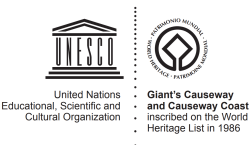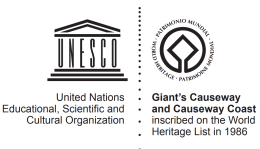The heritage of the Giant’s Causeway has taken on two distinct paths the natural geological formation and the cultural mythical stories.
Firstly we will consider with natural geological formation of the Causeway and after the folklore and cultural side of things will be explained.
Natural Heritage
The Causeway Coast began forming sixty million years ago with an episode of extensive volcanic activity and multiple flows of basalt lava all linked to the opening of what is now the North Atlantic Ocean. At 3,800km² the present day lava field constitutes Europe’s most extensive and this known to be smaller than the original size.
The lavas of the Antrim Group are divided into three main phases of activity, separated by two extended periods of limited local activity. During these intervening periods the upper surfaces of the lava flows were exposed to wet sub-tropical climatic conditions and weathering. The results of this can be seen as two, red coloured, inter-basaltic beds separating the Lower, Middle and Upper Basalts.
The Lower Basalts are a series of up to eleven complex olivine-rich flows. The Lower Interbasaltic Bed was formed by deep weathering of the upper flow of the Lower Basalt, possibly aided by the circulation of hot groundwater. The formation of the Interbasaltic Bed was accompanied by fluvial (water) erosion which produced an extensive drainage network in valleys. It was into these valleys that the lava of the Middle Basalts flowed, laying on top of the Interbasaltic Beds and Lower Basalts. It is this lava flow which has been exposed millions of years later as the Causeway Stones.
The Grand, Middle and Little Causeways were carved by the sea between Port Ganny and Port Noffer. Together they are made of approximately 40,000 vertical or gently inclined columns. The causeway stones owe their great number and regularity to the slow cooling and gradual contraction that took place at the base of the large mass of basalt.
The site was very important in the advancement of the concepts of volcanology in the late 18th and 19th Centuries. Etchings produced from the water colours of Susanna Drury made it one of the best known geological localities in the world at that time. More recently the columnar flows were described in classical architecture terms, using colonnade for the lower, wide and very regular columns, and entablature for the upper zone of narrower, more irregular and often curved columns(Tomkeieff,1940).
Cultural Heritage
The curious appearance of the Causeway Stones has long inspired folklore expressed in poetry, tales and music. Shepherds, fisherman and kelp gatherers have known about the Causeway Stones for centuries and they created their own story about the creation of the stones long before the geological formation was known of.
The myth goes something like this…Finn MacCool (or Fionn MacCumhail in Irish), an ancient mythical giant created the Giant’s Causeway as a means of getting across the channel to face his rival, the Scottish giant Benandonner. The effort of constructing the Causeway exhausted Finn so he fell asleep before he could cross to meet his rival. Before he woke Bennadonner used the Causeway to bring the fight to Finn. Finn’s wife Oona covered him with a blanket, telling the Scottish giant it was their baby son. Bennadonner took one look at the size of the baby and fled the scene fearing to face the father of such an enormous infant. Benandonner ripped up the Causeway as he fled, leaving only the coastal remnants at the Giant’s Causeway and Fingal’s Cave on the Scottish island of Staffa. Famous features to look out for at the site associated with the Finn MacCool legend include the Giant’s Boot, Giant’s Harp and the Giant’s Organ.
The Site contains a Historic Wreck Site safeguarded under the Protection of Wrecks Act 1973, the Girona. This wreck represents a significant period in European history. On 26th October 1588, the Girona, a galleas of the Spanish Armada, sank of Lacada Point, some three months after sailing from La Corunna. Of the 1,300 on board less than 10 people survived the sinking of the Girona, which is remembered in the name of the bay close to where she sank, Port Na Spaniagh.


